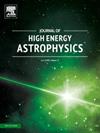The role of saturated thermal conduction in shaping electric current dynamics in jet-launching disks
IF 10.5
4区 物理与天体物理
Q1 ASTRONOMY & ASTROPHYSICS
引用次数: 0
Abstract
This study investigates the dynamics of jet formation from a viscous, resistive accretion disk around a young stellar object using MHD simulations with the PLUTO code. We conducted an in-depth analysis of electric currents from various perspectives to elucidate how their dynamics, influenced by saturated thermal conduction, impact jet acceleration and collimation processes. Our simulations confirm the butterfly topology of electric current lines, as predicted by earlier analytic models. Crucially, increasing the saturation parameter alters the current line topology: higher saturation enhances collimation in the inner disk regions while inducing decollimation in the outer regions. By the end of our simulations (, ∼112 rotational periods), higher results in a faster and more collimated jet compared to its lower counterpart, whereas at earlier times (, ∼32 rotational periods), the jet exhibits lower acceleration despite enhanced collimation. In our reference case, we find that the electric current lines connect the launching region to the Alfvén and fast magnetosonic surfaces from early times, confirming the effectiveness of the acceleration mechanism at the onset of jet formation. Our study reveals that the upper jet regions are transitioning toward Kelvin–Helmholtz instability (KHI), while the jet base continues to exhibit wave activity. At , doubling the saturation parameter reduces these oscillations and suppresses KHI, indicating faster plasma propagation. Analysis of the vertical profile of the current density, , shows a clear correlation between increased saturation and both enhanced jet acceleration and current density. Furthermore, the ratio of electric currents at the Alfvén point, , and sub-magnetosonic point, , indicates that higher saturation significantly improves the efficiency of matter propulsion and energy transfer within the jet.
饱和热传导在射流发射盘电流动力学形成中的作用
本研究利用冥王星代码的MHD模拟,研究了年轻恒星物体周围粘性阻力吸积盘的射流形成动力学。我们从多个角度对电流进行了深入的分析,以阐明它们的动力学如何受到饱和热传导、冲击射流加速和准直过程的影响。我们的模拟证实了电流线路的蝴蝶拓扑结构,正如早期分析模型所预测的那样。至关重要的是,增加饱和参数ϕs改变了当前的线拓扑结构:更高的饱和度增强了内部磁盘区域的准直,同时诱导外部区域的脱色。在我们的模拟结束时(t=700, ~ 112旋转周期),与较低的ϕs相比,较高的ϕs导致更快和更准直的射流,而在较早的时间(t=200, ~ 32旋转周期),射流表现出较低的加速度,尽管增强了准直。在我们的参考案例中,我们发现电流线从早期开始就将发射区域连接到alfv和快速磁声表面,证实了在射流形成开始时加速机制的有效性。我们的研究表明,高层喷流区正在向开尔文-亥姆霍兹不稳定性(KHI)过渡,而喷流基地继续表现出波动活动。在t=700时,将饱和参数加倍可以减少这些振荡并抑制KHI,这表明等离子体传播速度更快。对电流密度Jz垂直剖面的分析表明,饱和度的增加与射流加速度和电流密度的增强之间存在明显的相关性。此外,alfvsamn点IA和亚磁音点Ism的电流比表明,较高的饱和显著提高了射流内物质推进和能量传递的效率。
本文章由计算机程序翻译,如有差异,请以英文原文为准。
求助全文
约1分钟内获得全文
求助全文
来源期刊

Journal of High Energy Astrophysics
Earth and Planetary Sciences-Space and Planetary Science
CiteScore
9.70
自引率
5.30%
发文量
38
审稿时长
65 days
期刊介绍:
The journal welcomes manuscripts on theoretical models, simulations, and observations of highly energetic astrophysical objects both in our Galaxy and beyond. Among those, black holes at all scales, neutron stars, pulsars and their nebula, binaries, novae and supernovae, their remnants, active galaxies, and clusters are just a few examples. The journal will consider research across the whole electromagnetic spectrum, as well as research using various messengers, such as gravitational waves or neutrinos. Effects of high-energy phenomena on cosmology and star-formation, results from dedicated surveys expanding the knowledge of extreme environments, and astrophysical implications of dark matter are also welcomed topics.
 求助内容:
求助内容: 应助结果提醒方式:
应助结果提醒方式:


